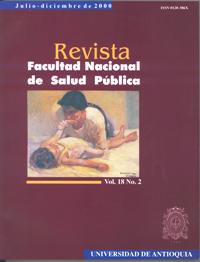Reference values of blood cholinesterase activity in the active labor force non-exposed to pesticides inhibitors of colinesterase
DOI:
https://doi.org/10.17533/udea.rfnsp.988Keywords:
Cholinesterase, Lovibond, reference values, working populationsAbstract
Downloads
References
(1). Henao S, Corey G. Plaguicidas inhibidores de las colinesterasas. Serie Vigilancia 11. Centro Panamericano de Ecología Humana y Salud. Metepec, México: ECO, OPS, OMS; 1991.
(2). Organophosphorous insecticides: a general introduction. Geneve, Switzerland: WHO, ILO, 1986. Environmental Health Criteria Nº. 63.
(3). International Programme on Chemical Safety (IPCS). Carbamate pesticides: a general introduction. Geneve, Switzerland: IPCS, 1986. Environmental Health Criteria Nº. 64.
(4). Whittaker M. Cholinesterase. New York: Karger Basel. 1986. Monographs in Human Genetics, Nº. 11.
(5). Guyton AK. Tratado de Fisiología médica. 8a ed. México DF: Interamericana-McGrawHill; 1992.
(6). Schwarz M, Glick D, Lowenstein Y, Soreq H. Engineering of human cholinesterases explains and predicts diverse consequences of administration of various drugs and poisons. Pharmacol Ther 1995; 67 (2):283-322. DOI: https://doi.org/10.1016/0163-7258(95)00019-D
(7). Aldridge WN. The nature of the reaction of organophosphorous compounds and carbamates with esterases. Bull WHO 1971; 44:25-30.
(8). Kangas J, Jauhiainen A. Determination of cholinesterase activity. Afr Newslett Occup Health and Safety 1991; 2:56-58.
(9). Michel HO. An electrometric method for determination of red blood cell and plasma cholinesterase activity. J Lab Clin Med 1.949; 34:1.564-1.568.
(10). Naab DP, Whitfield L. Determination of cholinesterase by the automated delta pH stat method. Arch Environ Health 1967; 15:147. DOI: https://doi.org/10.1080/00039896.1967.10664895
(11). Ellman GL et al. A new rapid colorimetric determination of acetylcholinesterase activity. Biochem Pharmacol 1961; 7: 88-95. DOI: https://doi.org/10.1016/0006-2952(61)90145-9
(12). Magnotti RA Jr, Eberly JP, Quarm DEA, McConell RS. Measurement of acetylcholinesterase in erythrocytes in the field. Clin Chem 1987; 33:1731-1.735. DOI: https://doi.org/10.1093/clinchem/33.10.1731
(13). Magnotti RA Jr., Dowling K, Eberly JP, and McConell RS. Field measurement of plasma and erythrocytes cholinesterases. Clin Chem Acta 1988; 315:315-332. DOI: https://doi.org/10.1016/0009-8981(88)90190-8
(14). Riddles PW, Blakely RL, Zerner B. Reassessment of Ellman's reagent. Methods Enzymol 1983. 91:4.960.
(15). Tintometer. Lovibond. The Lovibond cholinesterase test kit AF 267 (40-2670). Instruction. Virginia, USA.
(16). Henao S, Restrepo MP, Zapata FM, Marín LE, Ramírez H, Corrales R et al. Actividad colinesterásica en menores trabajadores. Antioquia (Colombia), 1989-1990. Medellín: Instituto de Seguros Sociales y Universidad de Antioquia; 1990.
(17). Della Rosa HV et al. Detección biológica de la exposición humana a agentes químicos. ECO/OPS/OMS. Metepec, México; 1991.
(18). Colombia, Departamento Nacional de Estadística DANE. Colombia Censo 85. Bogotá: DANE; 1986.
(19). Colombia, Gobernación del Departamento de Antioquia, Planeación Departamental. Anuario estadístico de Antioquia 1993. Medellín: Planeación Departamental; 1994.
(20). Ya Lun Chou. Estadística. México DF: Interamericana; 1972.
(21). Rider JA et al. Plasma and cell cholinesterase in 800 “healthy” blood donors. J Lab Clin Med 1957; 50:376-383.
(22). American Conference of Governmental Industrial Hygienists (ACGIH). Threshold Limit Values (TLVs) for chemical substances in the work environment adopted by ACGIH for 1995-1996. Cincinnati, USA: ACGIH; 1995.
(23). Klein-Scwartz W, Smith GS. Agricultural and horticultural chemical poisoning.Mortality and morbidity in the United States. Ann Emerg Med 1997; 29:232-238. DOI: https://doi.org/10.1016/S0196-0644(97)70274-9
(24). Andrade-Carvalho W. Fatores de riscos relacionados com exposiçao ocupacional e ambiental a insecticidas organoclorados no Estado da Bahia, Brasil, 1985. Bol Oficina Sanit Panam 1991; 115:255-269.
(25). Durán-Nah JJ, Collí-Quintal J. Intoxicación aguda por plaguicidas. Salud Pública de México 2000; 42 (1):53-55. DOI: https://doi.org/10.1590/S0036-36342000000100010
(26). McConnell R, Hruska AJ. An epidemic of pesticide poisoning in Nicaragua: implications for preventions in developing countries. Am J Public Health 1993; 83:1.559-1.562. DOI: https://doi.org/10.2105/AJPH.83.11.1559
(27). Câmara V de M, Corey G. Vigilância epidemiológica relacionada com substâncias de uso proibido na agricultura. Bol Oficina Sanit Panam 1995;119:135-139.
Downloads
Published
How to Cite
Issue
Section
License
The contents of the articles are the responsibility of the authors
The editorial committee has editorial independence from the National School of Public Health "Héctor Abad Gómez" of the University of Antioquia.
The editorial committee is not responsible for aspects related to copying, plagiarism or fraud that may appear in the articles published in it.
When you are going to reproduce and disclose photographs or personal data in printed or digital format, informed consent is required. Therefore, this requirement is required of the author at the time of receipt of the manuscript.
Authors are responsible for obtaining the necessary permissions to reproduce any material protected by reproduction rights.
The authors preserve the moral rights and assign the economic rights that will correspond to the University of Antioquia, to publish it, distribute electronic copies, include them in indexing services, directories or national and international databases in Open Access, under the Creative Commons Attribution license -Not Commercial-Share Equal 4.0 International Commercial (CC BY-NC-SA) which allows others to distribute, remix, retouch, and create from the work in a non-commercial way, as long as the respective credit and license are granted. new creations under the same conditions.
The authors will sign the declaration of transfer of economic rights to the University of Antioquia, after the acceptance of the manuscript.
The editorial committee reserves the right to reject the articles whose authors do not offer satisfactory explanations about the contribution of each author, to meet the criteria of authorship in the submission letter. All authors must meet the four criteria of authorship according to ICMJE: "a) .- That there is a substantial contribution to the conception or design of the article or to the acquisition, analysis or interpretation of the data. b) That they have participated in the design of the research work or in the critical review of its intellectual content. c) .- That has been intervened in the approval of the final version that will be published.d). That they have the capacity to respond to all aspects of the article in order to ensure that issues related to the accuracy or integrity of any part of the work are adequately investigated and resolved. "












 --
--  --
--
